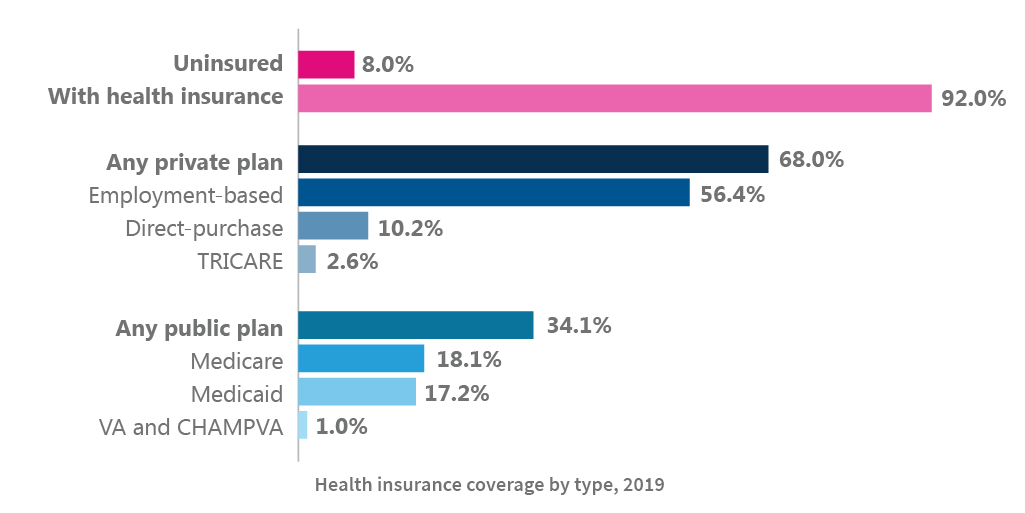New data from the Census Bureau reveals that 92% of people in the US had health insurance coverage for all or part of 2019, leaving 8%, or 26.1 million, without any coverage throughout the year.
The data comes from the annual Census report on Health Insurance Coverage in the United States, a compilation of findings from the Current Population Survey (CPS) and the American Community Survey (ACS).
Health insurance coverage by type, 2019

According to data from the CPS — which asks respondents about their health insurance coverage during the entirety of the previous year — an estimated 68% of the population had private health insurance at some point during 2019, 34.1% had public insurance, and 8% had no form of insurance coverage at all. The most common form of coverage was employment-based insurance, which covered approximately 183 million Americans in 2019.
In contrast to the CPS, the ACS asks respondents to report their health insurance status at the time of interview. The Census uses the ACS results to estimate year over year changes in coverage. According to this data, the number of people without health insurance at the time of interview increased from 28.6 million in 2018 to 29.6 million in 2019.
Insurance coverage in 2019 varied by age, race, and other characteristics.
Health insurance coverage varies by age, with the elderly and children typically insured at higher rates than other age groups. In 2019, adults aged 19 to 64 years had the highest uninsured rate at 11.1%, followed by children under 19 at 5.2% and finally, adults 65 and older, at 1.1%.
Coverage also varies with race and ethnicity. In 2019, the Hispanic population had the highest uninsured rate, with 16.7% of the population uninsured for the entire year. Among the Black population, the uninsured rate was 9.6% in 2019, followed by the Asian and white populations at 6.2% and 5.2%, respectively.
The likelihood of being insured also relates to poverty, work experience, and marital status. In 2019, the uninsured rate among people in poverty, people without full-time work, and unmarried people was higher than the uninsured rate among the total US population.
The percentage of people without health insurance increased in 19 states between 2018 and 2019.
According to data from the ACS, the uninsured rate among states varied from a low of 3% in Massachusetts to a high of 18.4% in Texas. Between 2018 and 2019, the uninsured rate increased in 19 states, remained the same in 30 states, and decreased only in Virginia.
The uninsured rate varied between states that did or did not expand Medicaid eligibility. In total, 32 states plus Washington, DC expanded eligibility to people below a designated income-to-poverty ratio threshold before January 2019. Among adults aged 19 to 64 in states with Medicaid expansion, the uninsured rate was 9.8%, compared to 18.4% in states that did not expand eligibility.
The individual mandate penalty was eliminated in 2019, meaning people no longer face penalties for being uninsured.
The Affordable Care Act included an individual mandate from 2014 to 2018, requiring people to have health insurance or pay a penalty when filing federal taxes. Between 2014 and 2018, those without coverage had to pay the penalty for each month that they went uninsured during the previous year, unless they qualified for an exemption.
The 2017 Tax Cuts and Jobs Act reduced the individual mandate penalty to $0, effectively eliminating the mandate starting in the 2019 tax year.
According to ACS data, approximately one million more people were uninsured at the time of interview in 2019 compared to 2018.
The most recent Census data shows how many people in the US had health insurance in 2019 — before the COVID-19 pandemic began.
The data reveals that private health insurance was more common than public health insurance in 2019, and specifically, that employment-based insurance covered 56.4% of the population. But amid the coronavirus pandemic, which has caused record unemployment, it’s likely that many have lost their employment-based health insurance.
The data on national health insurance coverage for 2020 will not be available until the fall of 2021.
Learn more from USAFacts and get the data directly in your inbox by signing up for our newsletter.
Keep exploring
Page sources and methodology
All of the data on the page was sourced directly from government agencies. The analysis and final review was performed by USAFacts.
Census Bureau
Health Insurance Coverage in the United States: 2019